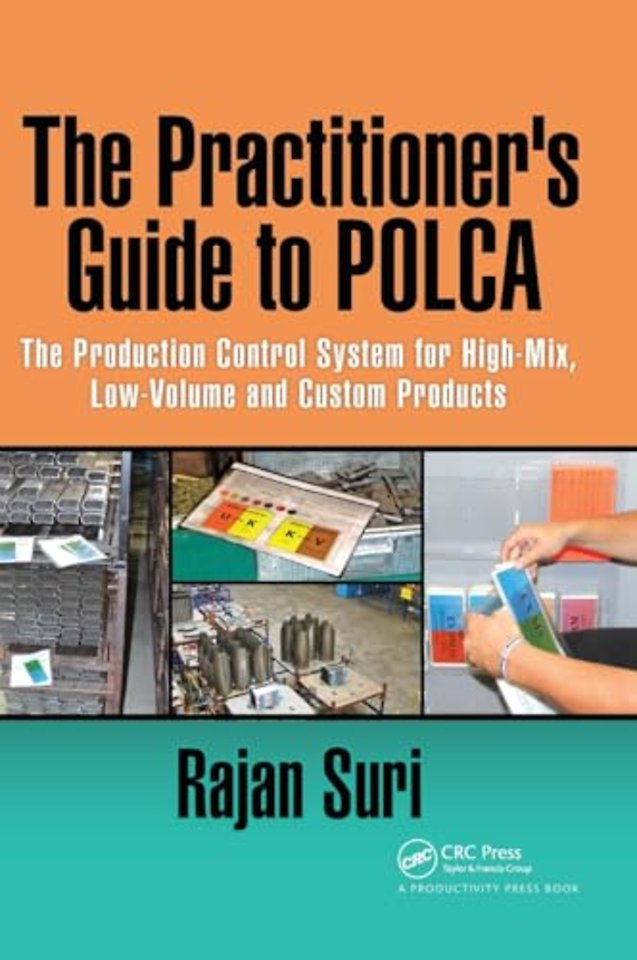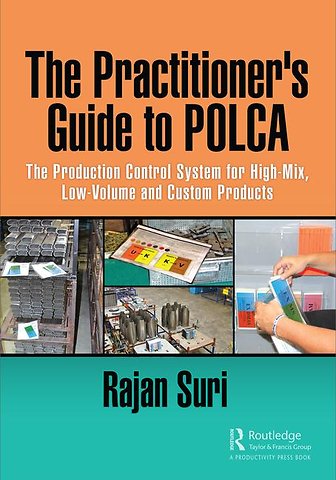



Rajan Suri is Emeritus Professor of Industrial Engineering at the University of Wisconsin–Madison.
Meer over Rajan SuriPractitioner's Guide to POLCA
The Production Control System for High-Mix, Low-Volume and Custom Products
Gebonden Engels 2018 1e druk 9781138210646Samenvatting
POLCA (Paired-cell Overlapping Loops of Cards with Authorization) is a card-based visual control system that manages the flow of jobs through the shop floor: at each operation, it controls which job should be worked on next to meet delivery targets. POLCA ensures that upstream operations use their capacity effectively by working on jobs that are needed downstream, while at the same time preventing excessive work-in-process (WIP) build-ups when bottlenecks appear unexpectedly.
POLCA is particularly suited to companies manufacturing high-mix, low-volume and customized products. Such companies struggle with long lead times, late deliveries, and daily expediting to meet delivery dates. ERP systems are not designed to deal with this highly variable environment, and add-on software such as Finite Capacity Scheduling systems can require complex installation. Also, the Kanban system does not work well with low-volume or custom production. POLCA has delivered impressive results in such environments. It does not require any complex software implementation: it can be used without an ERP system or it can seamlessly complement an existing ERP system.
This book:
-Provides a step-by-step roadmap on how to implement POLCA; invaluable for both companies that wish to implement POLCA as well as consultants and academics advising such companies.
-Explains the concepts in practical and easy-to-understand terms by showing detailed shop-floor examples.
-Includes more than 100 illustrations for understanding how POLCA works as well as for elaborating on details of the implementation steps.
-Contains case studies written by company owners and executives documenting their POLCA implementation process and the results achieved in various industries in six countries.
Specificaties
Lezersrecensies
Inhoudsopgave
1. POLCA—Simple Yet Highly Effective: A Tale of Two Companies
2. POLCA Explained: How It Works
3. Operational Benefits of POLCA
Part II: Implementing POLCA
4. Pre-POLCA Assessment, Prerequisites, and Preparation for POLCA
5. Designing the POLCA System for Your Situation
6. Accommodating Exceptions within the POLCA Framework
7. Launching POLCA
8. How We Designed and Launched POLCA in Three Days
9. Sustaining POLCA: Post-Implementation Activities
Part III: Industry Case Studies
10. From the United States: Using POLCA to Eliminate Material Flow Chaos in an Aluminum Extrusion Operation
11 From Canada: Applying POLCA in a Pharmaceutical Environment
12. From the Netherlands: Creating Flow and Improving Delivery Performance at a Custom Hinge Manufacturer through QRM and POLCA
13. From Belgium: Metalworking Subcontractor Reduces Lead Times by 85% Using QRM and POLCA
14 From Poland: Dancing the POLCA in a Glass Factory
15. From Germany: Yes, Even Small Companies Can Benefit from Implementing POLCA
Appendix A: Introduction to MCT: A Unified Metric for Lead Time
Appendix B: Overview of Quick Response Manufacturing (QRM)
Appendix C: Perspectives on Applying MRP, Kanban, or Some Other Card-Based Systems to HMLVC Production Environments
Appendix D: Capacity Clusters Make High-Level MRP Feasible
Appendix E: The Sociotechnical Success Factors of POLCA
Appendix F: Experiences with Using a POLCA Simulation Game
Appendix G: Explanation of Formula for Number of POLCA Cards
Appendix H: POLCA: A State-of-the-Art Overview of Research Contributions
Appendix I: Additional Resources for POLCA Training and Games
Index
About the Author
Anderen die dit boek kochten, kochten ook
Rubrieken
- advisering
- algemeen management
- coaching en trainen
- communicatie en media
- economie
- financieel management
- inkoop en logistiek
- internet en social media
- it-management / ict
- juridisch
- leiderschap
- marketing
- mens en maatschappij
- non-profit
- ondernemen
- organisatiekunde
- personal finance
- personeelsmanagement
- persoonlijke effectiviteit
- projectmanagement
- psychologie
- reclame en verkoop
- strategisch management
- verandermanagement
- werk en loopbaan





